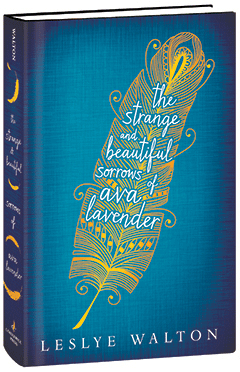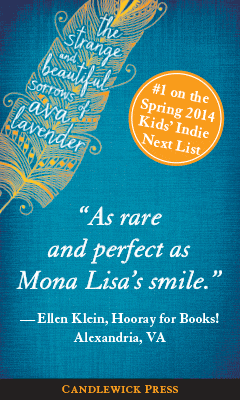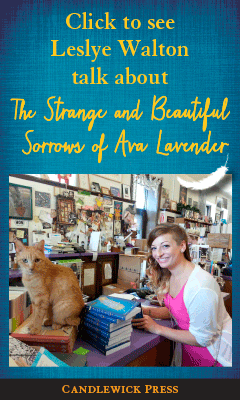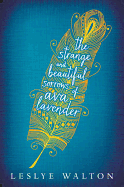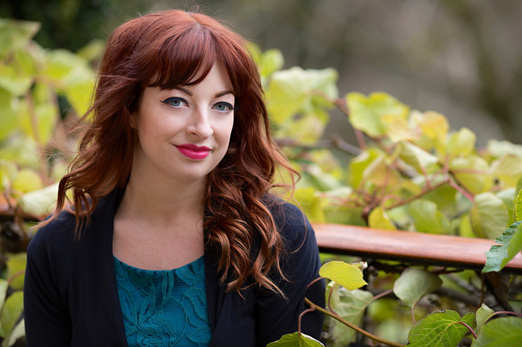The Strange and Beautiful Sorrows of Ava Lavender
by Leslye Walton
In a sweeping intergenerational story infused with magical realism, debut author Leslye Walton tethers grand themes of love and loss to the earthbound sensibility of Ava Lavender as she recollects one life-altering summer as a teenager.
"To many, I was myth incarnate, the embodiment of a most superb legend, a fairy tale. Some considered me a monster, a mutation. To my great misfortune, I was once mistaken for an angel," Ava begins in the prologue. Now 70 years old, Ava embodies all the sorrows and experiences of those who came before her, as if the wings she was born with might lift her up and away from life's disappointments. But Ava faces them--even though her mother and grandmother could not--and her sacrifice brings a healing balm to the entire family.
An ancient, leafy tree sketched at the book's start traces the lineage from Beauregard Roux, a beautiful, beefy phrenologist and his petite wife, Maman, on up through Ava Lavender and her twin, Henry. This image tips readers off that all will be well in the end, though these branches be bent and even broken many times.
Like Gabriel García Márquez did in One Hundred Years of Solitude, Walton's well-chosen details give readers enough to know and follow an entire cast of characters over several generations. And here, too, as with García Márquez's novel, the decisions of one generation make a profound impact on the next.
Emelienne, the oldest child of Beauregard and Maman Roux, born in 1905 and living with her family in New York City, falls in love with Satin Lush, transfixed by the "circle of light green in one of his eyes, the way it deliciously clashed with the cerulean blue of the other." They become engaged. Her sister Margaux, two years younger, becomes pregnant. The baby boy's mismatched eyes reveal his parents' betrayal. Margaux carves out her own heart; the baby dies soon after. Pierette, the youngest of the Roux children, falls in love with a birdwatcher at 15 and "took the extreme step of turning herself into a canary." Their brother, René, "fonder of the boys on his street than the girls," dies a brutal death at age 16, at the hands of his married male lover. As Emelienne says: "Love can make us such fools." It could be the family's mantra.
Emelienne enters into a loveless marriage and moves to Seattle in an attempt to escape her painful East Coast memories; she inherits her husband's bakery on Pinnacle Lane when he dies. Their only child, Viviane, falls in love with a man who cannot return it, yet in the garden on the night of the summer solstice, Jack Griffith leaves Viviane pregnant with twins--Ava and Henry. Brokenhearted, Viviane has not left the house since, and attempts to protect her children by keeping them with her.
Even teens encountering magical realism for the first time will be caught up in Walton's deft handling of decades in a few chapters, as she assuredly shows the minute details of one tragic night when Ava Lavender, Emelienne's granddaughter, accepts an invitation from Nathaniel Sorrows to step inside out of the rain.
What makes this a book for young adults is Ava's break from her family. Confined to her home, she gains the confidence, with her best friend, Cardigan, to slip out into the world with Cardigan and her brother, Rowe. Cardigan reveals Ava's wings on a spring night by the reservoir, and her peers accept them. "Children betrayed their parents by becoming their own people," Ava says. She must find a way to reach adulthood on her own terms, despite Nathaniel Sorrows's obsession with her wings and her mother's fear of revealing them. Ava is not an angel; she is a young woman. And that is how she wishes to live her life.
On the night that changes nearly every character in the book, Emelienne closes the bakery early. Henry has left home armed with maps he's made, leaving word clues like bread crumbs. Viviane, in search of Henry, leaves the house for the first time since the twins were born. She finds her son at the house of his father, Jack Griffith. On this night of the summer solstice, a festival to rival the 4th of July in their town, everyone must confront his or her greatest fear.
Like savoring a mille-feuille, readers will find layers to savor with each sampling of this novel. Supporting characters come alive with salient details. There's Wilhelmina Dovewolf, who leaves gifts in exchange for the bread she takes from Emelienne's bakery, and becomes Emelienne's friend and confidante; Gabriel, whose entry into Viviane's life signals "good love's arrival"; and Trouver the dog, who brings companionship to nearly mute Henry.
Walton presents challenges that most teens will hopefully never face. She writes of love, betrayal, birth, murder, affection and rape; yet she wraps them in prose so radiant that readers feel carried by Ava's narrative. The heroine's humor and wisdom as she looks back at her life let us know that she is a survivor, and readers will understand long before the seemingly luckless members of the Roux family that their fortune lay in their steadfast love and loyalty. --Jennifer M. Brown



